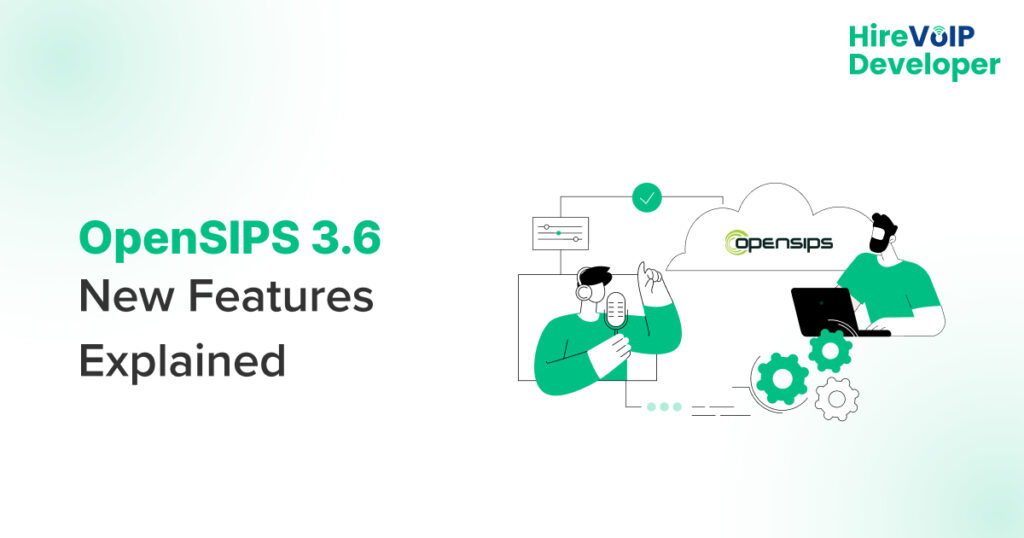📝 Blog Summary
OpenSIPS 3.6 introduces smarter tools for SIP routing, SDP manipulation, RTP handling, and dynamic deployments. This blog explains each new feature, why it matters, and how to start using it, with real use cases and migration tips. If you’re scaling or modernizing OpenSIPS, you’ll want to read this through.
If you’ve worked with OpenSIPS for long enough, you’ve probably dealt with a few pain points that never had clean solutions. OpenSIPS 3.6 doesn’t just add more features. It solves some of those problems.
This OpenSIPS release focuses on practical improvements like runtime socket control, structured SDP access, script-level profiling, and config logic that pulls straight from your database.
In short, it makes OpenSIPS easier to operate in a complex, modern infrastructure.
OpenSIPS 3.6 New Features
So, if you’re looking into OpenSIPS development, here’s what’s new and why you should know about it.

1. OpenSIPS Structured SDP Manipulation
You can now parse and manipulate SDP payloads as structured data, not just with regular expressions.
Use Case: Match specific codecs, enforce media direction rules, block ICE candidates, or rewrite payload attributes without brittle regex. Great for NAT traversal logic and VoLTE gateway deployments.
2. Dynamic SIP Sockets / Listeners
OpenSIPS 3.6 lets you add or remove SIP listeners at runtime without restarting.
Use Case: Running OpenSIPS in a dynamic IP environment (like containers or auto-scaling VMs)? This eliminates restarts when IPs change or when listeners need to be added temporarily.
3. Configuration Script Variables
You can now store variables that span across script restarts or reloads, defined in the configuration file.
Use Case: Store environment-specific values (e.g., region codes, DNS IPs, or debug toggles) in one place. This is helpful in multi-tenant setups or managed deployments.
4. Unified Branching Support
This update makes branching logic more consistent and simplifies how calls fork across different destinations.
Use Case: Cleaner implementation of call forking for contact lists, failover paths, or presence-based routing.\
Architecting OpenSIPS for scale, flexibility, and cleaner routing?
5. Enhanced REDIS Support
Clustered Redis and Redis Stack (JSON, Search, Bloom, etc.) are now fully supported.
Use Case: Build fast, distributed routing logic or real-time feature toggles using Redis as your central state engine.
6. RTP.io Embedded RTP Relay
You can now use RTP.io directly inside OpenSIPS to relay RTP streams.
Use Case: Remove external RTP proxies for simpler topologies. Useful in media-aware deployments where keeping RTP in path matters (e.g., call recording, lawful intercept, or early media)
7. AWS Integration (DynamoDB & SQS)
Out-of-the-box support for Amazon DynamoDB and SQS messaging.
Use Case: Build cloud-native SIP systems that interact with AWS-hosted databases and queues for provisioning, alerting, or distributed routing logic.
Install OpenSIPS 3.6
You can install OpenSIPS 3.6 by compiling from the official GitHub repo:
- Clone the 3.6 branch from the OpenSIPS GitHub.
- Build with make menuconfig to select only the required OpenSIPS modules
- Install via make install
Packages for major Linux distros may be available via nightly builds or from community-maintained repos.
To enable Structured SDP or RTP.io, ensure modules like proto_udp, proto_tls, sdpops, or rtpproxy are included in your build.
Also read: How to Configure OpenSIPS for Session Border Controller?
Migrate from OpenSIPS 3.5
While the scripting language remains mostly stable, here are things to watch:
- New modules may require additional parameters or permissions in config files
- Structured SDP: If you were manipulating SDP using regex, test the new structured mode thoroughly to avoid breakage
- Dynamic Sockets: Check any automation or orchestration scripts that modify listener bindings, and update them to use new runtime commands
- AWS/Redis Integrations: Ensure proper libraries and network access are in place if you’re planning to use these modules
Want to Start Testing OpenSIPS 3.6? Try This First
Not sure where to begin? These tests let you experiment with OpenSIPS 3.6 new features safely:
- Run two SIP endpoints through OpenSIPS using structured SDP
Test codec filtering, IP rewriting, and media attribute patching
- Simulate an IP change and add a listener dynamically
Use the MI interface to add/remove a new SIP socket on the fly
- Fork a call to multiple branches using Unified Branching
Observe cleaner logic and easier response handling in your script
- Write a JSON object to Redis Stack and read it back in the routing logic
Ideal for toggling feature flags or dynamic routing
OpenSIPS 3.6 isn’t packed with flashy features, but it solves real operational problems:
- No more restarts for listener changes
- Easier SDP manipulation without regex headaches
- Clean branching, Redis support, AWS hooks, and RTP relay options
These are practical changes that make daily OpenSIPS operations cleaner, faster, and more cloud-native.
If you’re modernizing your VoIP stack or building carrier-grade systems, our OpenSIPS development services can help you implement, test, and optimize your migration. It all begins here.


